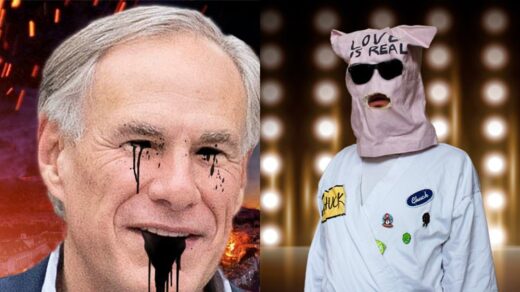An LGBTQ+ Climate Expert on the Future of Earth
I coauthored an award-winning children’s interactive iPad book a few years back called The House That Went on Strike. The story revolved around a family who ran roughshod over their home, with total disregard for how their actions affected the foundation and all that was within. Consequently, the house and all the appliances joined together, went on strike, kicked the family out, and refused to let them back in until they agreed to put things in order.
They say bad things come in threes. This year thus far, we’ve had the scourge and spread of COVID-19, and the ugly and unforgiveable reminders of systematic racism. Could the Earth’s frustration with our carbon-fueled arrogance be the final piece of the trifecta? In essence, is the Earth threatening to go on strike? Trying to kick us out in violent ways so that we finally address climate change?
I live in New York City, and our skies are not smoky but milky. That’s from the fires on the West Coast thousands of miles away. The pictures I see on my social channels from friends who live in California, Oregon, and Washington are horrific. I grew up in Pittsburgh, and back during the era of big steel, the city was the capital of steel production. In the early and middle parts of the 20th century, thick black smoke from the mills blanketed the city so badly that noon looked like midnight. The scenes of smoke from the West Coast fires remind me of those images.
The devastation is incalculable. Likewise with the multiple hurricanes that have hit the South and Southeast so far in this early part of the hurricane season. Things are so bad that forecasters and meteorologists who name the hurricanes in alphabetical order have depleted 26 names so far. What’s next in terms of how to name them (the Greek alphabet is next) takes a back seat as to what can we expect in the next two months as hurricane season truly starts to unwind?
I’ve written before about why climate change should be an LGBTQ+ issue and about my experience working with the scientists at the Nobel Prize-winning United Nations Intergovernmental Panel on Climate Change for several years in the run-up to the Paris treaty accord of 2015, to which over 200 nations signed on. Ignorantly, Donald Trump and his band of climate skeptics and carbon addicts pulled out of that important pact. In the interim, corporations and state and local government leaders have tried stepping up to take the lead on addressing the climate.
This week, standing amid one of California’s infinite number of burned-out forests, a true climate leader, Gov. Gavin Newsom, literally pleaded that we are past arguing whether climate change is real or not, saying, “And we come from a perspective, humbly, where we submit the science and observed evidence is self-evident that climate change is real and that it is exacerbating this [wildfires].”
On top of all this comes a thorough report this week in ProPublica (a must-read) about how the raging wildfires in the West, hurricanes in the East, droughts, and floods will create untold damage in the U.S. The article notes that as life becomes more untenable in these hard-hit areas, people will be forced to move — but where will they go?
So while I’m versed in climate change, I needed an expert opinion to answer a few questions that remain outstanding. Has Mother Earth finally had it with our behavior in her house? Are these fires really due to climate change, and are things going to get worse? What happens to these homes, businesses, communities, and dense forests that are torched and disintegrated? And as we all feel so helpless watching the fires burn from afar or see the milky skies from these fires 3,000 miles away, what can we possibly do to help?
I sought out the expertise of Dr. Lisa Graumlich, the out dean of the College of the Environment at the University of Washington. She is not only a member of our community and a leader in environmental studies in the U.S. but has been personally affected by the horrendous fires and smoke. An avid outdoors enthusiast, Graumlich is unable to bike and hike or be outside for an extended period of time because the air quality in her community and on campus is so bad.
Graumlich has been working in this field for most of her career. Like the many scientists and educators I worked with at the UNIPCC, she is soft-spoken, sincere, well-versed, and empathetic to the plight of our planet. I asked her if she agreed with Gov. Newsom that these fires are from climate change.
“I’m 100 percent sure that these fires now are due to climate change,” Graumlich answered without hesitation. “I have been talking about this for 15 years — the observation that small amounts of average temperature changes, even if it’s one or two degrees warmer, can cause adverse activity.”
Graumlich said that slightly hotter temperatures are reducing the snowpacks on the western mountains and nearby glaciers. “This warmer climate provokes the snowpacks to melt earlier, melt faster, and that causes the water from those snowpacks to retreat off the landscape earlier than usual, causing extremely dry conditions,” she said.
“Then you have record hot temperatures that we’ve experienced this summer that further dry out these forests, months ahead of the traditional fire season. Whether it’s the hot sun or a lightning strike, the effects of these on the forests become thousands of thousands of times worse because of the severe dryness.”
And this scenario has reached beyond California. “The whole West is burning, and that is something we have not seen before. This is exactly what climate change will do.”
What happens to the burned-out West and all the lives, homes, and communities these fires have destroyed? “Migration is a complex dilemma. We know the cost and hazards on the coast and in the wildland-urban interface where these forests are,” Graumlich explained. “We can defend against sea level rise, we can defend against tropical storms, and we can rebuild. And it’s harder to do with fires. But that’s going to start to change because all of this rebuilding is going to become an equity issue.”
Graumlich pointed out that the million-dollar homes that have been burned can be rebuilt, but for many of these small towns, and neighborhoods and homes that have been devastated, most of the people and communities might not be wealthy enough to rebuild, so their lives are being turned upside down. So choosing to rebuild or leave is a stark decision fraught with enormous implications. “As scientists we can say you can rebuild, but you have to be very eyes-open about what the costs will be.”
Wildlife and forests are also being destroyed. Nature seems to be shrinking. What happens to the millions and millions of acres of forests that are burned? Does nature rebuild them? “These burned-out forests will regrow, but it will take a long while. The problem we have immediately following fires is that we have got species coming from outside of North America, and they tend to alter the wildlife,” Graumlich said. “When the smoke clears the danger is not over. It’s a big reset. One in every 33 acres is burning right now in California, so when these trees grow back, they will be very young and very fragile, so you’ll see more landslides and mudslides that would have been prevented with stronger and more dense landscapes.”
When I tell people about my climate change experience, one of the first things I hear is “I recycle and drive a fuel-efficient car.” Others will say, I feel helpless, what can I do as a single individual? Graumlich has heard all of this and more for years, so she’s more adept than I am about pointing people in the right direction.
“First, I completely empathize with that helpless feeling. Look, most of the people who want to do more can do the math, and they realize that recycling or owning a Prius is not going to scale to the action that we all need to do,” she noted.
“They want to be responsible stewards, so we have to understand how, collectively, we can take action. I usually point them to Project Drawdown. It has about 100 ways a local or national community can take action to help. So if you care about food, for example, there is a role for you in the system. If you care about urban transportation and creating an environmental-friendly infrastructure, there’s a role for you there. Solar panels on K-12 schools. It’s a matter of everyone upping their game, from committees, urban planners, school districts, city councils, local organizations, and service clubs. If we all collectively go one step bigger, we can help solve this.”
When I told Graumlich about my book, I asked her if the story is an appropriate metaphor. We are abusing our global home. Is Mother Nature getting fed up and sending us a warning that she’s going to start taking more severe action? “First, I applaud that metaphor, but I think I have a more nuanced version of how the planetary system interacts with humans,” she correctly pointed out. “So I would say the warning signs about social disruption are here, particularly for those of us in the U.S.”
Like the scientists from around the world I spoke with, she also talked about the fact that it has been difficult for baby boomers, for example, to take climate change seriously in the past, because most scientists have told the public that detrimental climate effects might be 20 years out.
“People have generally felt that it’s so far away. But now these disruptions are here. I talk to my teenage daughter and her friends, and they don’t have any doubt that this is real,” she related. “The boomer generation grew up hearing that we were driving the planet, but that didn’t seem conceivable since the planet is so much bigger than us.”
“Over the last several decades, the world has gotten smaller and we’ve become more connected globally and socially,” she continued. “Now, finally, there’s the stark realization that the decisions we make are driving the planet after all. And this generation and the next sees this smaller world and connectivity, and the calamities of climate change seem much more real to them. In other words, they get it.”
And hopefully the next generation can start to finally put our Earth house in order and allow us to live without threat of eviction.
John Casey is a PR professional and an adjunct professor at Wagner College in New York City, and a frequent columnist forThe Advocate. Follow John on Twitter @johntcaseyjr.
Original Article on The Advocate
Author: John Casey






